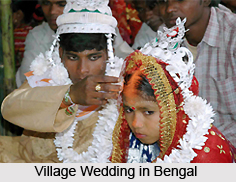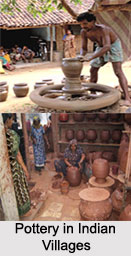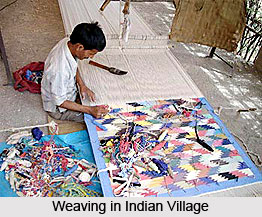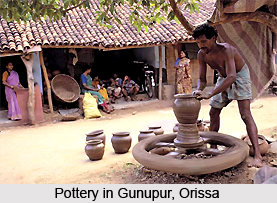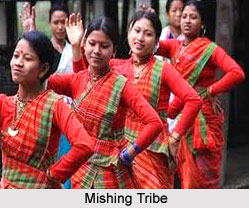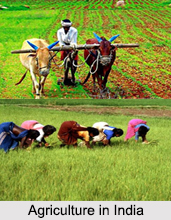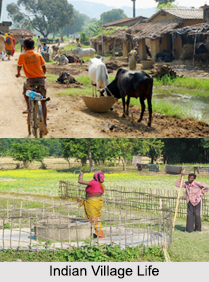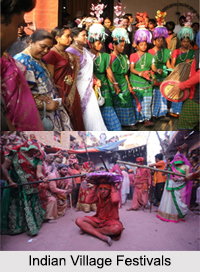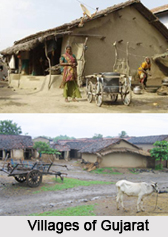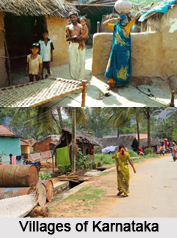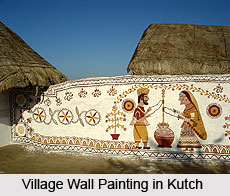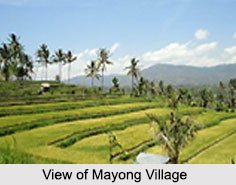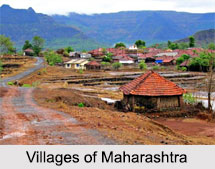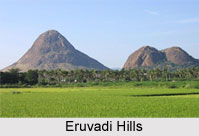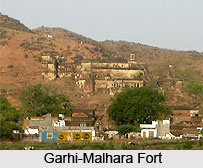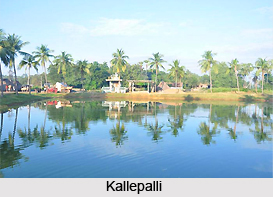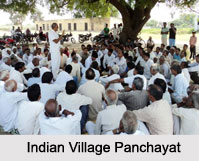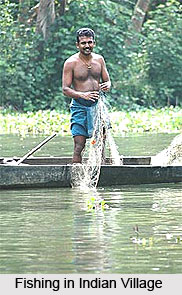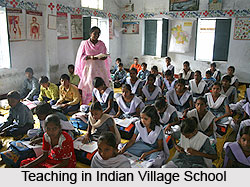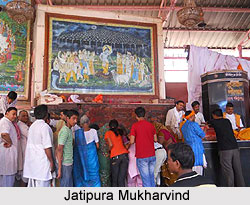 The Jatipura village (old Gopalpur) is located on the south western border of the Govardhan hill. The Vallabhite sectarians can be found in large number here. There are three Vallabhite temples in this village, which are known as haveh`s.
The Jatipura village (old Gopalpur) is located on the south western border of the Govardhan hill. The Vallabhite sectarians can be found in large number here. There are three Vallabhite temples in this village, which are known as haveh`s.
But, the famous shrine `Giriraj ka mukharvind` (meaning the lotus-face or the sun-face of Giriraj, alias Shri Nathji) or Bhogsila (meaning the food rock) are of prime importance of Jatipura village. The name of this shrine means `the rock to be fed by the devotees`. The term Mukharvind refers to a crack in the rock at its face.
Here, the god Baldev is offered only pakka (cooked) food but the only exception is acceptable during the Annakut and Makar Sankranti days on which both pakka and kacha (raw) foods are offered. During the Annakut festival, Gokulnathji is brought from Gokul to Jatipura village in a procession and placed in the temple. The Gokulnathji icon is a four-armed Visnu-Krsna, playing a flute. According to the Vallabhite tradition, the appearance of the `mukharvind` (means the blessed mouth of Shri Nathji) coincides with the arrival of the divine master Vallabhacharya in Jatipura village.
The rock deity is left bare for the morning puja as per the custom. At this time, the devotees worship it with pots and buckets of milk throwing on the naked rock as per the custom of that area. The milk which flows down is lapped up by the dogs eagerly. They somehow arrive here during this festival in Jatipura village. The idol is then covered wholly by the Krishna Gopals own attire.
At present days, the Jatipura Mukharvind is worshipped as a swarupa icon of Krishna Gopal, himself identified in Vallabhite belief with the Lord of the Govardhan hill. The Jatipura village is now regarded to be the most prestigious place for the celebration of the Govardhana puja or the Annakut festival. The village has become mainly a Vallabhite centre. On the festival day, the Vallabhite havelis (private houses) are kept open for all Hindus without distinction of caste. On that day, all can watch the huge display of food, including kacha (uncooked) food, normally protected from all impure looks and prasad (holy food) which is later distributed to all. It is a common superposition prevailing all over the Braj area.
Another festival of Jatipura village is the Annakut celebration. It is assumed to be as a kind of compromise between the archaic pattern of the festival, as celebrated by the rural population of Braj and the Vallabhite faith in their own swarupa idols. Actually the Vallabhites could do without the `Jatipura mukharvind` as they believed that Shri Govardhan nathji emerged from the hill long ago, through the power of the master Vallabhacharya, and was subsequently carried away to safety in Mewar. Hence all the Vallabhite maharajas used to celebrate the Annakut festival within their own havelis for the sake of their own adepts.
The Vallabhites believed in the presence of their ancient deity within the sacred hill and it is evident from the presence of three secondary swarupa icons at the time of the Annakut festival in Jatipura and also due to the presence of the old rock as a make believe effigy of Krishna-Gopal himself.
